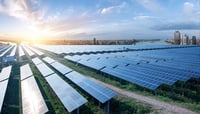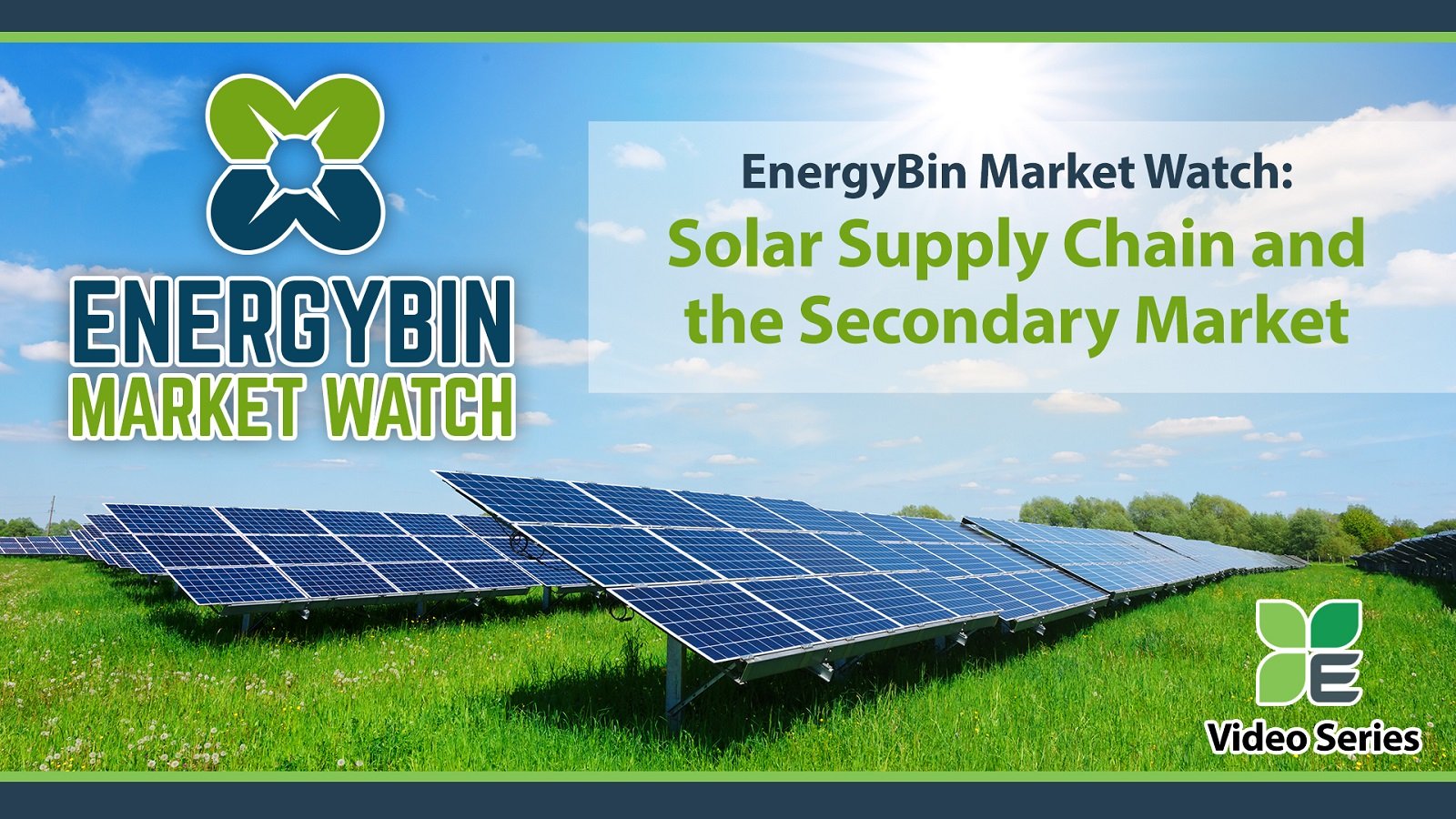The following article is the transcript from an interview with Thomas Hennessey, business development manager at EnergyBin, who shares insights about current supply chain constraints, secondary market trends, and what to expect moving into 2022.
Click on the video to view the interview.
Hello. Welcome to this edition of Market Watch brought to you by EnergyBin, the leading B2B solar community for PV repair, resale, and recycling.
I’m Melissa Schmid, marketing manager at EnergyBin, and I’m joined by my colleague, Thomas Hennessey. Thanks for being here, Thomas.
Today, we’re discussing the solar supply chain and the secondary market. Before we get into our topic,
1. Tell us about your role and what you like most about working in the solar industry.
Thomas: I am the business development manager here at EnergyBin, and I love my job. I’m essentially a matchmaker, and we are connecting solar companies all around the world - buyers and sellers alike. My favorite part about working in the solar industry has been solving companies’ problems. We hear success stories nearly every day, and it feels good to be a part of the renewable energy push.
That’s great, Thomas, and I hope you will share some of these success stories later in this interview. First, I want to chat more about supply chain constraints.
Across industry news, I’m reading about rising PV prices both in the U.S. and Europe, as well as sky-rocketing freight costs. In fact, in the U.S. module prices have risen by $0.06-0.08/Wp. Analysts don’t expect inflation to ease anytime soon.
In addition to rising equipment prices, we’re seeing skyrocketing freight costs. Rystad Energy warns that the increase in freight costs could delay or cancel up to 56% of global utility-scale developments planned for next year.
I’m also reading about supply shortages across many brands and product lines. Shortages are partly due to the global chip shortage and partly due to trade sanctions on components originating from the Xinjiang province in China.
2. What are you hearing in the field from solar companies about equipment supply these days?
Thomas: The supply problems are intensifying all over the country and globally as well. Nearly every company I talk to is dealing with a supply dilemma in some way, shape, or form. We are starting to hear more about delays and cancellations because companies can’t find equipment on time. Lead times are stretching further and further out. I think that it is important to plan for that and take advantage of alternative options like EnergyBin.
3. What are the alternatives for sourcing and selling PV equipment, that is, when primary vendors don’t have what buyers need or when primary buyers aren’t purchasing what vendors have?
Thomas: Great question. When vendors don’t have what buyers need, or buyers aren’t purchasing what vendors have, I would encourage both parties to consider the secondary market. The secondary market opens a lot of doors for solar companies that aren’t finding what they need through their primary vendors. As a buyer, EnergyBin gives you access to 500+ potential new vendors. Chances are, one of our members has the module or inverter you are looking for. On the flip side for vendors, if buyers aren’t purchasing certain types of equipment, consider listing product on the secondary market. EnergyBin helps expand your reach, so buyers in other areas have access to your product as well.
For our viewers, I think it’s important to define the secondary market. In a nutshell, it is an alternative market where buyers and sellers can go for solar equipment that falls out of the primary distribution channel. As one example, a developer or EPC can resell material resulting from a cancelled project. Other examples include surplus, excess from bulk purchases, clearance items, and liquidations.
4. What hesitancies do solar companies have about PV resale?
Thomas: Solar companies can be hesitant to list product or buy on the secondary market. I feel like there is a negative connotation associated with the secondary market, and there is a sentiment that all equipment on the secondary market is “used” or imperfect in some way. More times than not, this is not true. Equipment can end up in the secondary market for a variety of reasons, as you mentioned. The majority of the equipment that we see is brand new. Many resellers are not confident that there is a secondary market, and are hesitant to dive into it. I talk to a lot of installers who think they’re too small to reap the benefits of the secondary market. These are all fallacies. I think any company can stand to gain from the secondary market so long as they’re committed to it.
From our positions in the industry, we would both affirm there absolutely is a secondary market. A robust and sustainable secondary market is a critical element to ensuring we achieve a circular economy in the solar industry.
5. How can solar companies ensure they experience success in the secondary solar market (buying and selling)?
Thomas: The most important thing is commitment in my opinion. Whether you’re a small installer or an international manufacturer, you will experience success in the secondary market if you have commitment. For buyers and sellers alike, companies that are proactive about sending their want-to-buy and want-to-sell broadcasts (mass e-mails) are enjoying more success. For manufacturers, distributors and resellers, you have to treat EnergyBin as you would your internal CRM system. EnergyBin gives you access to hundreds of new buyers. Post your inventory, send your mass e-mails, and do your best to make new connections and expand your network.
I really like that word, commitment. It makes a lot of sense to me. You would have to treat it like part of your daily operations in order to see the results you’re looking for.
I understand another concern or hesitancy solar companies have about PV resale is their uncertainty regarding pricing goods. I would recommend your best success to apply an accurate price is to work with an appraiser, and do your research. Particularly if material is used, you’ll want to work with a qualified appraiser, who can test the goods for functionality, safety, and performance.
If the material is new, use platforms like EnergyBin to search and compare prices on the part number. Those who accurately price their material are seeing the best results in the secondary market.
6. How can solar companies ensure they are engaging with qualified buyers and sellers online?
Thomas: It’s always important to know who you’re doing business with. Fortunately, we take care of some of the legwork here at EnergyBin. All members are vetted on the front end. We look for a functional website, and we require tax numbers and business references before allowing companies on our site. EnergyBin is a safe business environment for buyers and sellers alike. I encourage companies to contact me when they have questions about new members they’ve not done business with yet.
I would add that many of our resellers on EnergyBin are doing business on multiple online marketplaces, including operating their own e-commerce stores.
7. When choosing what site to list equipment for resale, what factors do you recommend solar companies take into consideration?
Thomas: Consider your target market, and consider transactional fees. There are other platforms with solar equipment listed for sale, but few are dedicated exclusively to solar. EnergyBin is great for sellers, because we have a large group of solar companies actively looking for equipment. Every time that you send out a “broadcast” e-mail on our platform, your message is viewed by hundreds of companies. With transactional fees, most platforms are charging 15%+ per transaction. Whereas, we only charge for the yearly membership here at EnergyBin.
I look at EnergyBin not as a cost but rather an investment. It’s more so the value that you receive with the membership. Like you would joining an association or a chamber of commerce, it’s part of the value of doing business via connecting with your industry peers within the EnergyBin community.
8. Will you share a story with us about a solar company’s success doing business in the secondary market?
Thomas: One of my clients comes to mind - John from 2ndlife Batteries. He successfully sold several inverters to Minnesota Solar Supply within his first month of membership. His comment to me was one of satisfaction with respect to the dollar investment he made via his EnergyBin membership dues. I believe the sale came out to be more than 26 times his return on investment.
It’s this kind of story that justifies the secondary solar market within the solar industry. As we wrap up this interview, let’s look into the future. 2022 is just around the corner. We’re aware of all the existing supply chain issues. Yet, demand continues to climb. Globally, the International Energy Agency expects new solar and wind capacity to total 280 GW next year. In the United States, Wood Mackenzie forecasts an average of 29 GW of new solar capacity each year through 2026.
9. What are your predictions for the secondary solar market in 2022?
Thomas: I believe that the secondary market will continue to grow in the coming years, and I think that 2022 will be a big year. With inflation rising, supply chain issues worsening, and the labor shortage, I think that many companies will have no choice but to entertain the secondary market. Realistically, supply issues will persist through 2022, and I think that we are only seeing the tip of the iceberg. My advice to companies would be, don’t put all of your eggs in one basket. Now is the time to diversify your business and look into sourcing and selling in the secondary market.
Thank you, Thomas, for your insights. I’m sure you’re more than willing to talk one-on-one with any solar company who would like to look into EnergyBin as an alternative solution for sourcing and selling.
For our viewers, be sure to subscribe to our YouTube channel, and check out EnergyBin’s website for more resources on buying and selling solar equipment in the secondary market.
From the entire EnergyBin team, we wish you a prosperous and fulfilling 2022.
More Resources:
 The Ultimate Guide to Buying Wholesale Solar Equipment
The Ultimate Guide to Buying Wholesale Solar Equipment
 The Ultimate Guide to Selling Wholesale Solar Equipment
The Ultimate Guide to Selling Wholesale Solar Equipment
